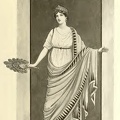The early chiton. At the beginning of the sixth century B.C. men
followed the example of the women by adopting the Ionic chiton for
general use. The masculine variety was a shortened version of the original worn by the women, and reached to just above the knees. In its early stage (sixth century B.C.) it was no more than a rectangular piece of linen, or wool, folded round the body and fastened on each shoulder by buttons or brooches, and round the waist by a girdle; or it could be girded under the arms. It was worn open down one side, and these two edges were usually finished off with a fringe, probably the raw edges left in the weaving.
- Auteur
- Costume and Fashion
The evolution of European dress through the earlier ages
By Herbert Norris
Published in 1924
Available at archive.org - Ajoutée le
- Dimanche 15 Novembre 2020
- Dimensions
- 320*712
- Mots-clés
- Costume, Place:Greece
- Albums
- Visites
- 1236
- Téléchargements
- 44
 Télécharger la photo
Télécharger la photo





